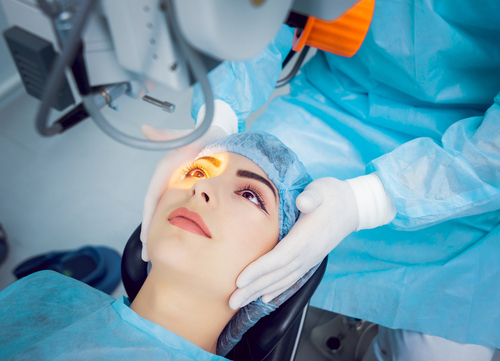Are you considering laser vision correction but feeling confused about which procedure is right for you? Two of the most common vision correction procedures, PRK and LASIK, offer similar results but differ in important ways.
Keep reading to learn more about what the difference between PRK and LASIK is, and which procedure might suit your vision needs.
How Do Vision Correction Procedures Work?

Before diving into the differences between PRK and LASIK, it’s helpful to understand what these procedures are designed to accomplish.
The primary function of our eyes is to focus light precisely on the retina, which then transmits visual information to the brain.
If your cornea is irregularly shaped, light doesn’t focus properly on the retina. This results in refractive errors like nearsightedness, farsightedness, or astigmatism.
Both PRK and LASIK use an excimer laser to reshape the cornea, allowing light to properly focus on the retina and improving vision without glasses or contacts. The primary difference lies in how they access the cornea.
What is LASIK?
LASIK (Laser-Assisted in-situ Keratomileusis) is currently the most popular laser vision correction option. During LASIK, your eye doctor will create a thin, hinged flap in the cornea using a femtosecond laser.
This flap is gently folded back to expose the underlying corneal tissue. They then use an excimer laser to precisely remove microscopic amounts of tissue to reshape the cornea according to your unique vision needs.
Once complete, the flap is repositioned and adheres naturally without stitches. LASIK offers patients a quick visual recovery, with most experiencing improved vision within 24 hours.
The procedure also causes little to no pain and takes less than 30 minutes to complete.
What is PRK?
PRK (Photorefractive Keratectomy) was the first widely performed laser vision correction procedure before LASIK was developed. During PRK, the thin outer layer of the cornea is completely removed to allow your eye doctor to reshape the underlying corneal tissue with an excimer laser.
After the procedure, the epithelium naturally regenerates over the following days. It offers the same long-term results as LASIK, but it does take longer to recover from due to the removal of the epithelium.
Key Differences Between LASIK and PRK
While LASIK and PRK can both correct nearsightedness, farsightedness, and astigmatism by reshaping the cornea, the fundamental difference between these procedures is how the corneal tissue is accessed. LASIK involves making a corneal flap to reshape the underlying corneal tissue, but PRK removes the outer epithelial layer completely, which then regenerates naturally.
The result is certain differences in recovery experiences and candidacy requirements:
Recovery Time

After LASIK, most patients experience vision improvements within 24 hours and are able to return to work and driving after just one day of healing. However, PRK recovery is more gradual, with initial healing taking three to five days.
Discomfort Level
LASIK offers patients minimal discomfort, typically described as a gritty sensation for a few hours. The PRK recovery experience is slightly more challenging, with mild discomfort for the first few days while the epithelium regenerates.
Candidacy Considerations
PRK is often recommended as an alternative to LASIK for certain patients who do not qualify for the procedure. You may be a better candidate for PRK than LASIK if you have thin corneas, dry eye, or play contact sports.
This is because the corneal flap created during LASIK can pose a risk of complications to those groups of patients. For example, an injury during contact sports could dislodge the corneal flap and lead to vision impairment, or the disturbance of corneal nerves during LASIK could worsen dry eye.
Because PRK does not require making a corneal flap, it is often safer for patients who are not good LASIK candidates.
Am I a Good Candidate for LASIK or PRK?
To qualify for both PRK and LASIK, you should:
- Be 18 years or older
- Have stable vision for at least one year
- Not be pregnant or nursing
- Have nearsightedness, farsightedness, or astigmatism within the range that LASIK and PRK can correct
- Not have eye conditions like cataracts or glaucoma
- Not have autoimmune conditions like diabetes, Sjogren’s syndrome, rheumatoid arthritis, or lupus that could complicate healing
- Have realistic expectations about what vision correction procedures can achieve
Your eye doctor at South Texas Eye Institute will conduct a comprehensive consultation where they will review your medical history, measure your prescription, examine your corneas, perform an eye exam, and discuss your lifestyle and vision goals to determine whether PRK or LASIK is right for you.
What are the Results of LASIK and PRK?

Despite their differences in technique, candidacy requirements, and recovery, both PRK and LASIK offer excellent long-term outcomes. Most patients enjoy crisp, clear vision for decades and complete freedom from glasses and contacts.
The “better” procedure truly depends on your individual eye characteristics, lifestyle needs, and personal preferences. It’s important to note that while LASIK and PRK both offer permanent vision correction, it is still possible to experience vision changes in the future due to unrelated eye conditions like cataracts, glaucoma, presbyopia, or macular degeneration.
Ready to discover which procedure might be right for you? Schedule an appointment at South Texas Eye Institute in San Antonio, TX, today!

